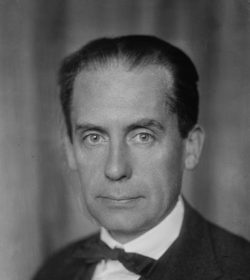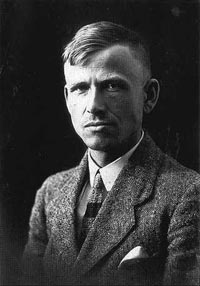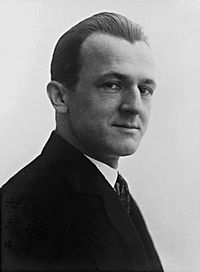Otto Dix (1891-1969) was a German artist who produced many works critical of both World War I and Weimar society. Born in Thuringia to a blue-collar family, Dix trained as an artist from childhood. He enlisted in the German army in early 1915, saw extensive service as a machine gunner on both the Eastern and Western Fronts, and won the Iron Cross.
After the war, the traumatised Dix returned to his painting. Influenced by expressionism and Dada, his work became darker, cynical and more political. Like his fellow artist and collaborator George Grosz, Dix explored anti-war themes and criticisms of Weimar society. Dix’s work was more graphic, sometimes including shocking depictions of dismembered bodies and disfigured war veterans.
Dix’s criticisms of the war and German militarism made him a target for the Nazis. After Hitler’s rise to power Dix was dismissed from his teaching positions in Dresden, while his more controversial paintings were seized. Dix survived Nazi rule and World War II and continued to produce anti-war paintings until his death.

Walter Gropius (1883-1969) was the founder of the Bauhaus artistic and architectural movement. Born in Berlin, Gropius followed his father and uncle into architecture. He set up his own business in the capital and explored modernist designs in his work, abandoning traditional materials in favour of glass and steel. Gropius was conscripted into the military and served as an officer on the Western Front during World War I.
In 1919, Gropius was appointed as head of the Weimar School of Arts and Crafts. Under his tutelage, it became the crucible of Bauhaus, a movement that Gropius claimed would “embrace architecture and sculpture and painting in one unity… rising toward heaven from the hands of a million workers”. At the Bauhaus school several artists, including Gropius himself, pioneered new styles and designs in art, architecture, decor, furniture, interior design and typography. Bauhaus became Weimar Germany’s best known artistic oeuvre; the Bauhaus building in Dessau – with its modular shapes, glass panes and distinctive sign – was both a model and a temple for the movement.
In the late 1920s, Gropius moved away from the Bauhaus school and returned to private practice in Berlin, where he designed large public housing projects. In 1934 Gropius was forced to flee Nazism, later taking up residence in the United States.
George Grosz (1893-1959) was an artist and illustrator, best known for his involvement in Dadaism and his depictions of life in Weimar Germany. Born in Berlin, the son of a publican, Grosz undertook art studies as a teenager. He served in the army in 1914 before being discharged on medical grounds. In 1919 Grosz became involved in the Spartacus Uprising; he later joined the German Communist Party but left the party as a protest against dictatorial violence in the Soviet Union.
During the 1920s Grosz created scores of paintings and illustrations, many of which touched on political and social themes. Topics covered in Grosz’s work include political corruption, militarism, the inequalities of capitalism, the mistreatment of war veterans, urban life, Weimar decadence and eroticism.
Vehemently opposed to the Nazis, Grosz left Germany shortly after Hitler’s rise to power in 1933. He spent the rest of his life in the United States, where he taught art in New York and continued to paint until his death.

Fritz Lang (1890-1976) was probably Germany’s best known film-maker during the Weimar period. Born in Vienna to a Jewish mother, Lang was raised Catholic and briefly trained as an engineer, before transferring to art. He served on the Eastern Front during World War I, rising to the rank of lieutenant.
Shortly after his discharge, Lang began working in filmmaking, where he adapted and incorporated expressionist techniques from his study of the visual arts. Lang’s first significant film was Doctor Mabuse, a dark psychological story that intertwined crime, hypnosis and immorality. Lang’s best-known work, Metropolis, was completed in 1927.
The rise of Nazism curtailed Lang’s career. He emigrated to the United States, reportedly after being offered the role of the chief filmmaker for the Nazi regime.
Erich Maria Remarque (1898-1970) was a veteran of World War I and one of Germany’s best known writers during the Weimar period. Born in north-western Germany, the son of a bookbinder, Remarque was conscripted into the army in June 1917. He served barely a month on the Western Front before being wounded and invalided for the rest of the war.
After the armistice, Remarque trained as a teacher but also began writing novels. His best-known work was All Quiet on the Western Front, written in 1927 and published two years later. It became hugely popular in both Germany and the West, though it divided political opinion. All Quiet on the Western Front was despised by the Nazis, who felt that it discredited the memory of German soldiers.
On coming to power the Nazis ordered Remarque’s books to be burned as degenerate literature. They later guillotined Remarque’s sister, Elfriede. In 1936 Remarque, by now living in Switzerland, penned Three Comrades, a novel set in the decadent and politically volatile environment of Weimar Germany. Remarque continued to write until his death in 1970.
© Alpha History 2018-23. Content on this page may not be republished or distributed without permission. For more information please refer to our Terms of Use.
This page was written by Jennifer Llewellyn, Jim Southey, Brian Doone and Steve Thompson. To reference this page, use the following citation:
J. Llewfilmmakers, “Weimar Republic artists, writers and filmmakers”, Alpha History, accessed [today’s date], http://alphahistory.com/weimarrepublic/weimar-republic-artists/.



